Introduction to Blue Mosque
The Blue Mosque, the turquoise and unique mosque of the Islamic world, is a representative of the ancient Persian architecture. The turquoise color of this mosque is so stunning that it refreshes your life and you can experience a unique tranquility during worship. The Blue Mosque is also known as a part of Mozaffariyeh’s large collection and has a school, monastery, library, etc. next to it. Over the years, the overall texture of this collection has been damaged. This enchanting blue is now the only remnant of the reign The Qaraquyunlus in their capital, Tabriz. The existence of this complex in the heart of Tabriz, which is also adjacent to the Silk Road, added to its importance. Finally, after many days of the glory of this historic and valuable monument, only parts of it remain today.

Naming of Blue Mosque
Kaboud Mosque or Blue Mosque is known among the Azeri-speaking compatriots as Goi Machid and is also known as Blue Mosque, Mozaffariyeh Mansion, and Jahanshah Mosque and is one of the prominent examples of Islamic architecture in Tabriz and is known as “Turquoise of the Islamic World”. And because Europeans know azure blue by the name of Persian blue, they have given the title of the blue mosque to this building and azure tile has been used in Kaboud mosque more than any other mosque.
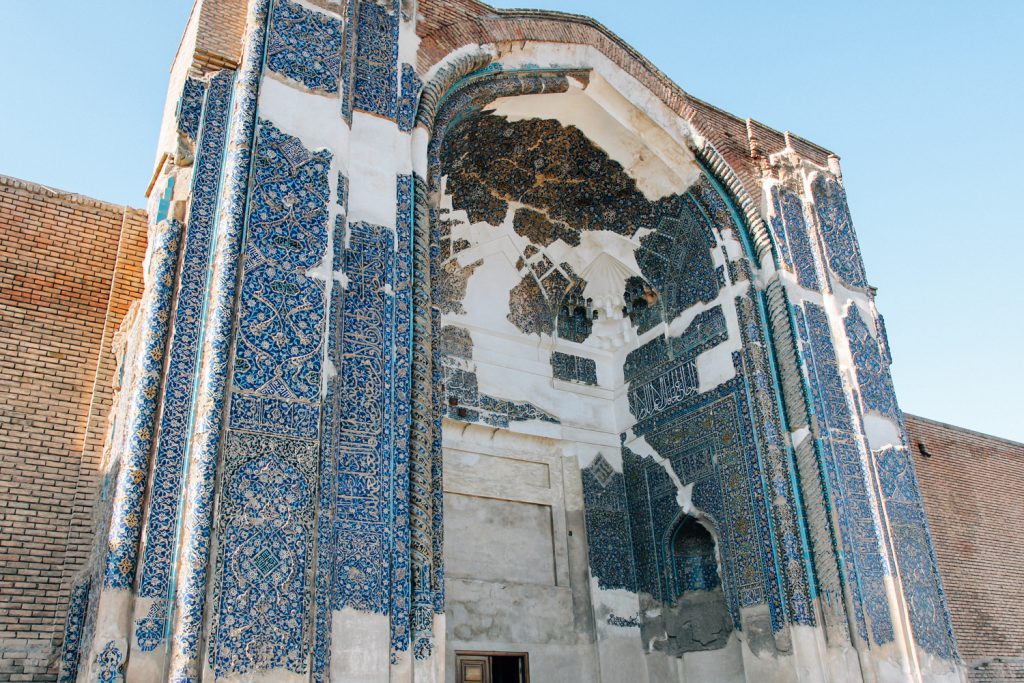
Architecture of Blue Mosque
Blue Mosque, the Magic of Architecture and Color
The Blue Mosque is a multi-purpose building built in the style of Azeri architecture; Its tiling, bedding, and muqarnas are its features. This building is used as a mosque-tomb because it is used both as a mosque and there are tombs in the southern part of it. Unlike other mosques of its time, this mosque did not have a mezzanine and was built to be adapted to the climate of Tabriz, covered and roofed, and made it usable in all seasons.
The portal, minaret, dome, nave, and family tomb in the southern part of the mosque are the main parts of this complex, which have also changed due to the destruction. The building of this mosque is made of bricks. Parts of rare stones have been used and in the restoration of the mosque, an attempt has been made to use the remaining bricks, tiles, and marble stones in their original places. Due to the wonderful design of the mosque’s indoor air system, you can feel the pleasant airflow here. Tabriz Blue Mosque is one of the three blue mosques in the world in terms of the amount of art used in architecture and its original role and twist, two of which are in Turkey and Afghanistan. The mosque, designed by the best professors of its time, is still unique despite all the wounds it inflicts, and it captures the heart of every viewer.
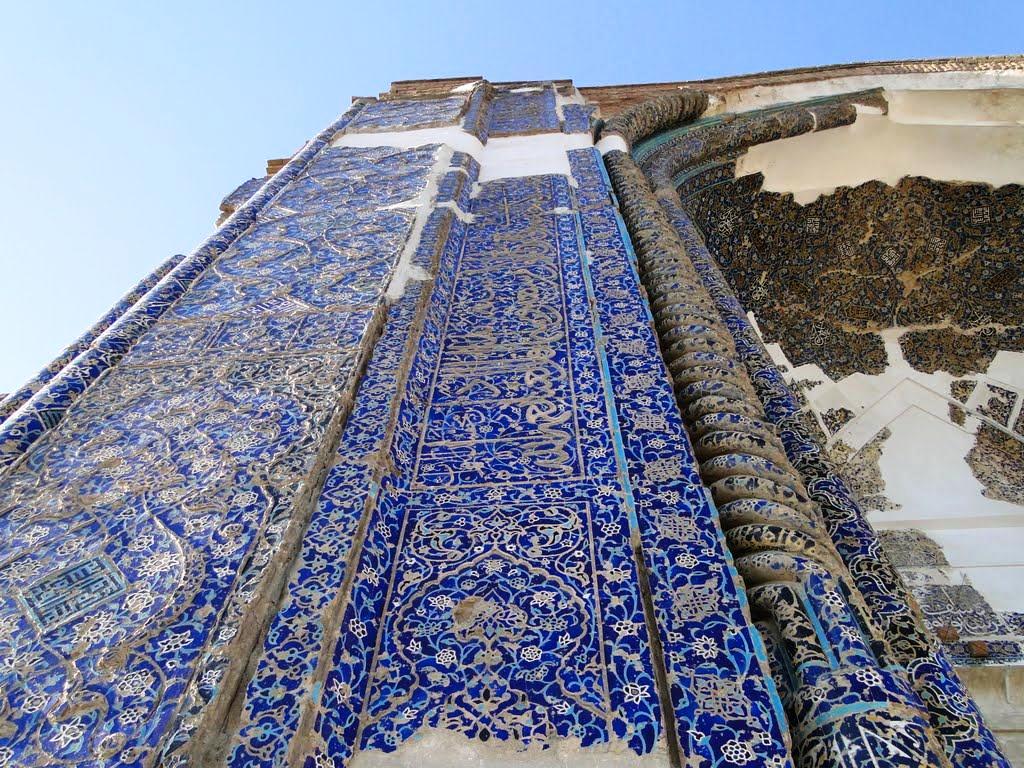
History of Tabriz Blue Mosque
In the ninth century AH the Qaraquyunlu Turks ruled over Azerbaijan. During this period, the ruler of this dynasty, Abu al-Muzaffar Jahanshah ibn Qara Yusuf, known as Jahanshah, decided to build a mosque in his capital, the city of Tabriz. He eventually built a complex called Mozaffariyeh, which included the Blue Mosque, the library, the caravanserai, the baths, and so on. Jahanshah’s wife, Jan Begum Khatoon, or some of her other daughters, Saleh Khanum, is said to have supervised the construction. As the inscription on the entrance of the mosque shows, the construction of the building was completed in 845; Of course, this date indicates the year of the completion of the tiling, and the construction of the mosque was probably completed a few years before this date. It is said that this amazing mosque was a ceremonial and honorary mosque during its heyday and was based on complex philosophy and ideas.
In 1158 AD, an earthquake struck and destroyed all the buildings of the Mozaffariyeh Royal Complex, leaving less than 20 percent of the mosque. As a result of this earthquake, the domes of the mosque collapsed and its building was seriously damaged. This mosque was nothing more than a ruin until more than 150 years after the earthquake, until in 1318 A.D. during the first Pahlavi period and at the same time with the formation of the Persian Historical Monuments Preservation Association, restoration and protection of healthier parts, including arches and foundations. Were considered. The wall that you see in the mosque today was built between 1338 and 1343 AH, and the main dome and the small dome were rebuilt between 1352 and 1354 with the design and supervision of Master Reza Memaran.

Tourists’ comments about the Blue Mosque
The scribe of Chalabi and the French tourist Tavernier visited Tabriz and this building and wrote descriptions of it. Chalabi has written about the mosque as follows: The doorway of the Jahanshah Mosque is higher than Kasra Arch. It is a magnificent building adorned with eye-catching tiles, high domes, etc, a magnificent mosque that anyone who enters it will not be allowed to leave. The building is decorated with dazzling tiles, has tall domes, and all its doors and walls are designed with colorful tiles. In addition to the gates and tiles, Tavernier also mentions two very tall minarets that were destroyed in the earthquake.
The Spectacular Parts of the Blue Mosque
The Portal
The size and height of the entrance to the Blue Mosque is the first thing that attracts attention, and the height of the entrance is only twice its width; But due to an eye error, the viewer imagined the height of the entrance more than that. The entrance is divided into three sections, two large pedestals and a multiplicative arch on them, and two pedestals in the middle, which is the location of the entrance. The entrance of the mosque also has inscriptions in the third line and paintings in Kufic script, and the spinal column around the arch of the entrance is triple.
On both sides of the mosque’s entrance, there is the finest and most versatile type of mosaic tile, which is still considered one of the most complete examples of mosaic in the Islamic era. In this tile work, the writings have been delicately and accurately mosaiced, and Kateb Chalabi has described this in his book History of Worldview.
Dome and Dome
There are two significant domes in the Blue Mosque that form the two domes of the house and the large dome with a diameter of 17 meters is located on the large and main courtyard and is one of the largest domes built in Persia and around the large dome. There are interconnected porches that are connected to the surrounding porches by arches on three sides.
Another dome is located on the small and southern courtyard and belongs to the Jahan Shah family tomb. The entrance porch of the mosque on the north side is the only entrance to both domes, and the two minarets of the mosque are located almost on both sides of this porch, and 7 smaller domes are located on the roofs of the eastern and western naves and the entrance of the mosque. The remarkable thing about the domes of the Blue Mosque is that they did not use any structures to build them. The original dome of this mosque was one of the largest brick domes of the ninth century AH.
The great earthquake in Tabriz destroyed this dome, and the information that is currently available about the characteristics of the blue dome is taken from the writings of people who have seen its main dome, because the current dome is not its main dome, and as a result, restoration has taken place. It is impossible to know the original form of the dome before the demolition and there is not enough evidence about it; But two visual documents, including the miniatures of Mottracci and the French Croc Chardin, have contributed somewhat to this recognition. The interior of the large dome of the mosque is made of small bricks and colorful tiles, and the role of flowers and idols and Arabic sentences and words can be seen in it.
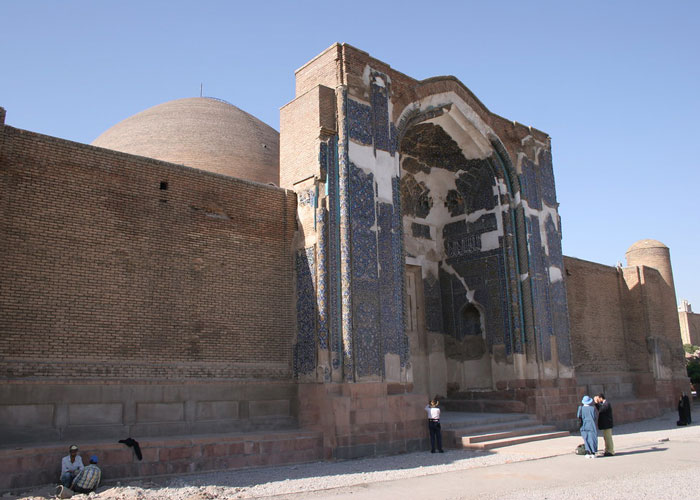
The Inscriptions of the Blue Mosque
- The header inscription is written in Kufic script and one-third. The inscription also shows the names of Muzaffariyeh’s mansion and the name of Nematullah ibn Muhammad al-Bawab, a prominent Azerbaijani artist who was a calligrapher and designer of mosque designs.
- An inscription in Raqa script on the tiles of the entrance porch of the mosque, which speaks of the date of construction of the building in 870 AH.
- A prominent inscription with the theme of Surah Fatah, which has been worked around the main nave with elegance and beauty, and shows that this building was a place to commemorate the victories of Jahanshah.
- Marble adorned with Quranic verses in the small nave
- An inscription with the name of Jahanshah at the top of the entrance of the mosque, which in the past was covered with gold.
- An inscription of Persian poems on the back door of the entrance to the great nave with the theme: Do something and don’t look around, because if it is done, tell the work that you did.
On both sides of the mosque, there are cruciform and broken crosses depicted in the Russian invasion of Tabriz, and these paintings are among the oldest Persian paintings.
Courtyards and Porches
The Blue Mosque has a large square courtyard with a pool for ablution, and naves as a shelter for the poor, and a small courtyard to the south of the mosque, which also houses a small nave. In the north and east of the mosque courtyard, porches that are related to the present and have recently been added to the complex.
Columns
In the main courtyard of the mosque, there are columns, which have stairs to access the porches overlooking the courtyard, and at the base of these columns, there are small chambers that were most likely used as shoes and have been changed today.
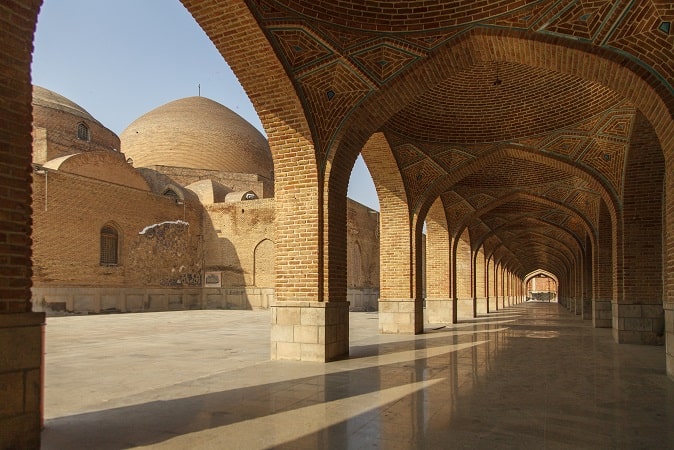
Sardabeh, the Tomb of Jahanshah
Due to the location of the tomb of Jahanshah and his wife in the crypt section of the Kaboud Mosque in Tabriz and its use is the tomb-mosque, this crypt is located in a small nave in the southern part of the mosque and these tombs may be the burial place of Jahanshah. The body of Jahanshah was transferred to the mosque after his death. His and his wife’s grave, both are currently empty.
According to the description of Tavernier, a French tourist, a marble and altar were covering at the junction of this section with the dome, which has no trace today. Until the mosque was destroyed, there was traffic on both sides of the altar, but today it has been converted. This section has been carved in the past with azure hexagonal tiles, marble plinths, and inscriptions with Islamic motifs, and the marble floor and ceiling are decorated with gold paintings. These inscriptions include verses from the Qur’an that are written delicately and artistically in the Islamic script in the third line.
Gold and Azure Ceilings
The spelling roof of this mosque, which has a colorful combination of gold and azure in its heart, which is full of tranquility with bruised tiles along with golden motifs, is only a part of the surprising beauty of Tabriz Blue Mosque.
Tiles
Tabriz Blue Mosque, like many other works of Persian-Islamic architecture, has artistic tiles and is one of the main reasons for the popularity and beauty of the elegant mosque tile art. The exterior and interior walls are decorated with mosaic tiles. You will see a variety of tiles in the magnificent blue mosque, and marble azure hexagonal tiles and inscriptions with Islamic motifs are among the beauties of this part of the mosque. Excavations at the mosque found 38 graves, including two skeletons of men and women, along with burial objects, and sent them to the National Museum of Azerbaijan. Since then, artifacts from the Iron Age cemetery and natural sediments have been found. And the works of the Islamic period have been obtained.
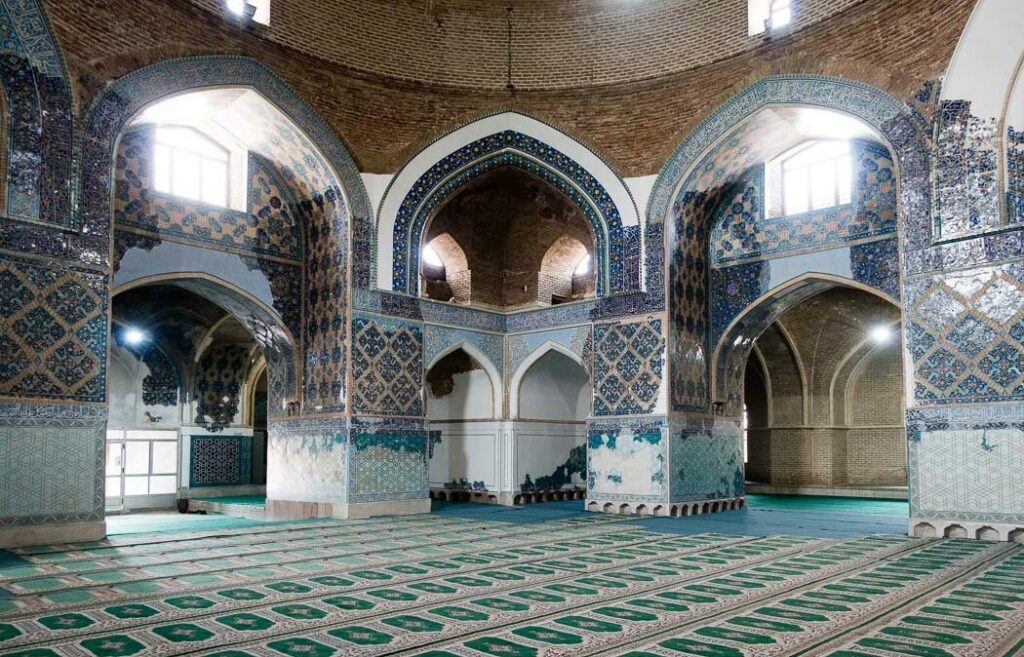
Location of Blue Mosque
Kaboud Mosque is located in Tabriz city in East Azarbaijan province and is located on Mansour Street in Tabriz, not far from Saat Square, inside Khaghani Park.
When to Visit Blue Mosque
Tabriz has a moderate weather, but it gets very cold on autumn and winter. From the beginning of March to the end of April and from the beginning of September to the end of November is the best time to visit this area.
Where to Aat Near Blue Mosque
Tabriz Ruby Restaurant
Yaghoot Tabriz Restaurant placed in the the 5* Pars Hotel, is one of the greatest restaurants in Tabriz, located on Imam Khomeini Street in this city and near the Blue Mosque. This restaurant offers a variety of food with good quality for the guests.
Tabriz Shahriar Traditional Dining Room
Shahriar Tabriz Traditional Canteen is one of the most important canteens located in Saat Square of this city. This canteen is the first and oldest canteen in Tabriz that has a magnificent atmosphere and has been listed on Historical Monuments of Persia on hot days. Every year, its roof is used to accommodate guests to enjoy their food in a relaxed and pleasant atmosphere.
Haj Majid Restaurant in Tabriz
Haj Majid Restaurant, is one of the greatest restaurants in Tabriz, located on Ferdowsi Street. This restaurant is famous for its Chloo Morgh (rice and chiken), which is delicious and well qualified.
Where to Stay Near Blue Mosque
Tabriz International 4* Hotel
With its unique architecture and pleasant, spacious interiors is located in one of the best central neighborhoods of Tabriz with great amenities and eye-catching views in the heart of the historic part of Tabriz. The amenities at the hotel are satisfying, the restaurant is qualified enough to bring you comfort during your residence in Tabriz city.
Hotel Esteghbal
This hotel is one of Tabriz famous and old neighborhoods, giving you easy access to Tabriz sights.
Park Hotel
Tabriz Park Hotel is located in the center of Tabriz and with more than half a century age, is one of the oldest hotels in this city and so good to mention that the distance from this hotel to Tabriz Bazaar is only 6 minutes by car!
Pars Elgoli Hotel
Pars Elgoli 5* Hotel with a full glass view is one of the best hotels in Persia on the roof of Tabriz City, which is one of the best accommodation options in Tabriz. This hotel is close to Tabriz shopping malls. Guests can enjoy a relaxed, pleasant setting with a unique view of Ail Goli Park. The hotel’s revolving restaurant, with its eye-catching views and varied Persian dishes with delicious taste, is always ready to welcome the dear guests of this hotel.
Shariar Hotel
Tabriz Shahriar International 5* hotel is a unique hotel located in the heart of Tabriz in a green area. Due to its convenient location, the accessability to places of interest and shopping centers in the city, such as the traditional bazaar of Tabriz, has become very easy. Shahriar Hotel offers its services in accordance with the latest international hotel standards and with the aim of providing comfort and convenience to the guests. The hotel has a large Cactus and Landscape Restaurant, multi-purpose reception halls, conference rooms, a variety of shops, special services for the disabled, a coffee shop, and an amphitheater.
How to Get to Blue Mosque
Flying to Tabriz is one of the best and fastest ways to reach this city. Tabriz Martyr Madani International Airport (TZB) hosts domestic and foreign flights and is one of the most well-equipped international airports in the country. Tabriz Airport also provides you with transportation access to various locations.
Traveling by train would make your journey poetic and romantic while you can watch the view of Aras Baran Jungles through the train window and imagine yourself among the Aras Baran trees, the dewdrops on your skin, and the cool breeze that blows through your hair.
How to Visit Blue Mosque
We will visit the Turquoise Mosque in Tabriz to immerse ourselves in the Turquoise Mosque of the Islamic World. It is permissible for the entrance of the mosque to be blue and enchanting. Inside the mosque, a unique silence and tranquility was established to see this building stunning the travelogues of the traveler of the Grand Mosque. A unique til art that has earned the world the title of Turquoise Mosque for this mosque. A mosque that can stand on its own two feet despite its misfortunes, and with its porches, courtyards, domes, and naves, its powerful eyes are saturated with elegance and beauty.

